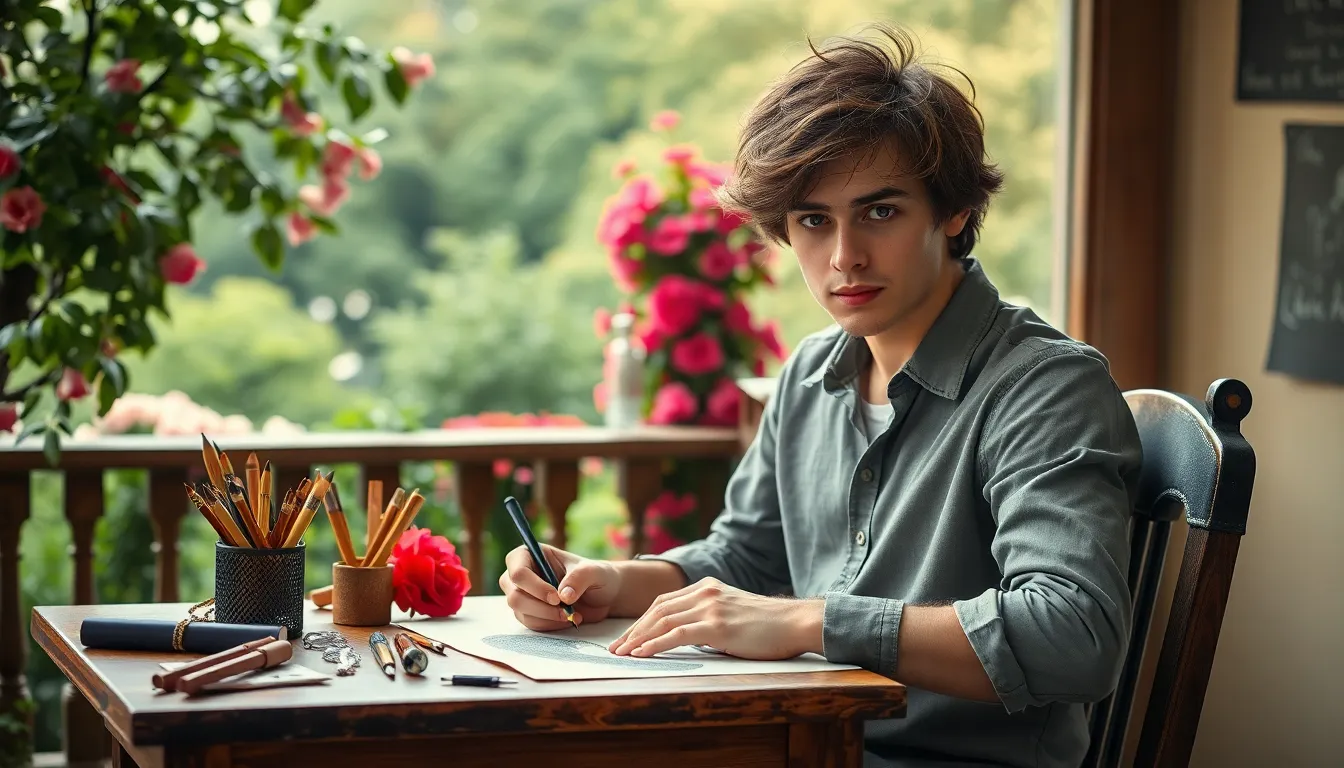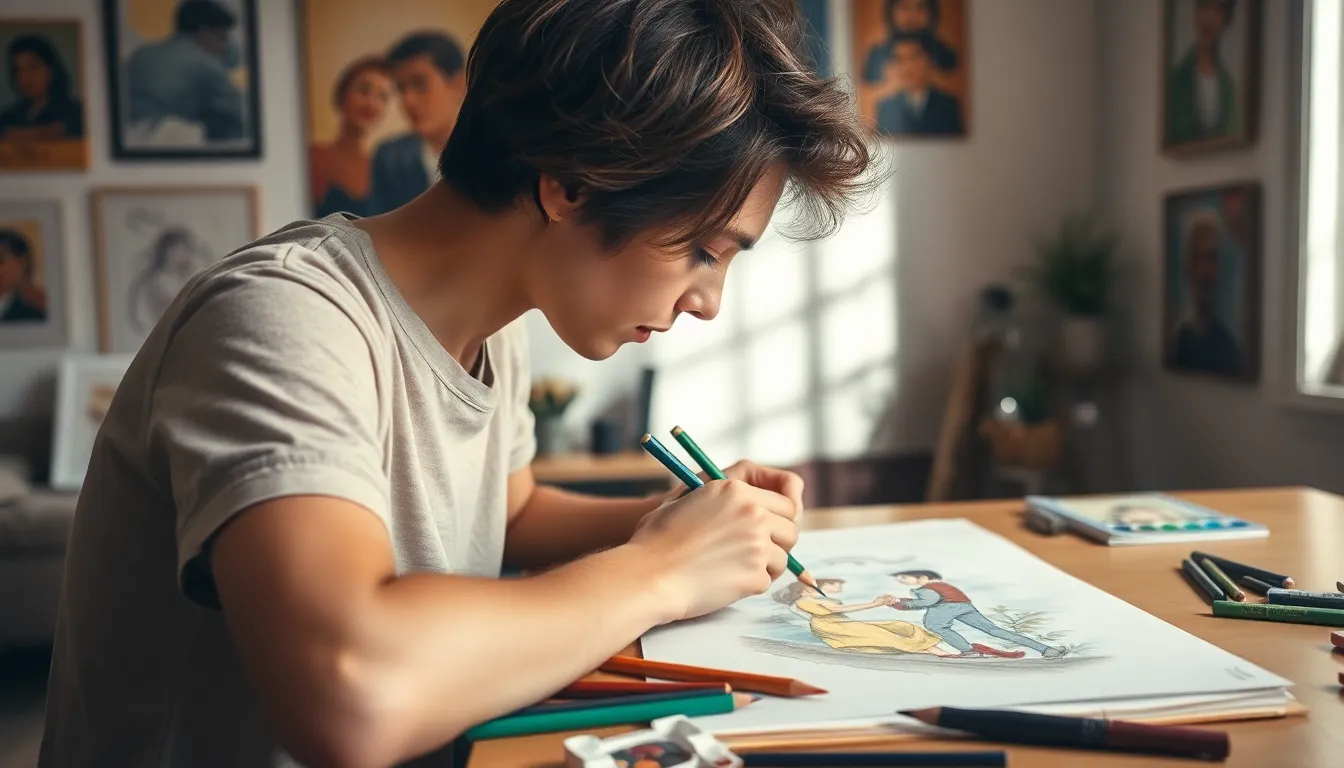When it comes to classic love stories, few rival the tale of Romeo and Juliet. But what if instead of just reading about their tragic romance, one could bring it to life through art? Imagine capturing the essence of these star-crossed lovers with just a pencil and a dash of creativity. Drawing Romeo and Juliet doesn’t have to be a daunting task reserved for seasoned artists; it can actually be a fun and accessible adventure for everyone.
Table of Contents
ToggleOverview of Romeo and Juliet
Romeo and Juliet stands as one of William Shakespeare’s most significant works, exploring themes of love, fate, and conflict. Set in Verona, Italy, it unfolds the story of two young lovers from feuding families, the Montagues and the Capulets. Their tragic romance captures the essence of youthful passion and the consequences of rivalry.
Characters play crucial roles in developing the narrative. Romeo, a Montague, embodies impulsive love, while Juliet, a Capulet, demonstrates innocence and profound commitment. Their decisions, often driven by emotion, set off a chain of events leading to their untimely deaths.
Symbolism enriches the text. The balcony scene highlights the intimacy between Romeo and Juliet, while the poison symbolizes the destructive nature of hatred. Such symbols invite artists to interpret and express these moments creatively.
The historical context adds depth. During the Renaissance, societal norms constrained personal relationships. Shakespeare critiques these conventions through the forbidden love of Romeo and Juliet. Their struggle against fate resonates deeply within modern audiences.
Creating drawings inspired by this play offers a creative outlet for individuals. Through art, they can capture critical moments, such as the iconic balcony scene or the poignant finale. These illustrations allow for personal interpretation and expression, providing a unique connection to Shakespeare’s narrative.
Ultimately, the story of Romeo and Juliet transcends time, continuing to inspire countless adaptations and artistic expressions. It resonates with themes of love and conflict, making it a wellspring of creativity for those willing to explore its depths through drawing.
Tips for Easy Drawing

Capturing the essence of Romeo and Juliet through drawing can be a fulfilling experience. Focus on the following tips to make the process enjoyable and simpler.
Understanding Character Features
Examine Romeo and Juliet’s distinctive features. Romeo often displays a youthful charm, with tousled hair and expressive eyes. Juliet’s beauty shines through her delicate face and flowing hair. Observing various character expressions enhances drawings. Study images from adaptations to grasp different interpretations. Sketch different angles to capture their emotions effectively. Use reference images to understand their clothing, combining historical elements with personal flair.
Exploring Key Scenes
Identify pivotal scenes that resonate with the story’s themes. The balcony scene represents hope and longing, making it an excellent choice for drawing. Illustrating the moment captures the tension and emotion shared between the lovers. Another moment to consider is the tragic ending, portraying deep sorrow and loss. Sketching these scenes allows for creative interpretation, opening pathways for unique artistic expression. Utilizing bold lines and color contrasts can enhance the impact of each drawing. Consider varying perspectives to bring new insights to classic moments.
Step-by-Step Drawing Techniques
Techniques for creating drawings inspired by Romeo and Juliet can be simple and enjoyable. These steps guide artists through sketching characters and capturing iconic moments.
Sketching the Characters
Start with basic shapes to outline their forms. Use ovals for heads and rectangles for bodies to establish proportions. Focus on facial expressions that reflect their emotions. Capture Romeo’s passionate gaze and Juliet’s innocent look. Gradually add clothing details to convey their identities. Reference historical attire for authenticity. Consider their body language, which tells much about their relationship. Keep refining the lines to achieve desired expressions and poses. Add intricate features like Juliet’s flowing hair and Romeo’s distinct features to bring life to the sketches. With practice, replicating these characters becomes an exciting journey in artistic expression.
Capturing Iconic Moments
Famous scenes in Romeo and Juliet offer rich opportunities for artists. Begin by selecting key moments, like the balcony scene or the tragic ending. Visualize the emotions and dynamics between the characters. Use diagonal lines to create tension and movement in the composition. Capture Juliet’s hopeful gaze as she leans over the balcony or Romeo’s yearning expression below. Incorporate background elements that represent Verona, enhancing the scene’s context. Experiment with light and shadow to evoke emotions and drama. By focusing on these iconic moments, artists communicate the deep feelings of love and fate inherent in the story.
Tools and Materials for Drawing
Several essential tools aid in bringing the characters of Romeo and Juliet to life through drawing. Pencils, including varying hardness levels, are crucial for sketching initial outlines and adding details. Erasers, both kneaded and vinyl, offer flexibility for corrections and smooth transitions.
Inks and fine liners play a vital role in defining the final artwork, adding boldness to the lines around the characters. Markers provide vibrant colors, enhancing the emotional intensity of the scenes. Watercolors, with their ability to blend, can create soft backgrounds reminiscent of the Verona setting.
Paper choice significantly impacts the overall outcome. Drawing paper supports pencil, ink, and watercolor techniques, while heavier cardstock provides durability for mixed media. Sketchbooks are useful for experimenting with ideas before finalizing pieces.
Other tools include rulers and compasses for maintaining proportion and symmetry. Blending stumps or tortillons facilitate smooth transitions between shades. Additionally, a lightbox can aid in tracing and refining images.
Organizing materials efficiently enhances the creative process. Keeping tools within reach, whether in a dedicated art space or portable kit, fosters spontaneity. Setting a comfortable workspace allows focus and inspiration to flow freely.
Together, these tools and materials equip artists with the means to capture the essence of Shakespeare’s characters and pivotal scenes, allowing personal interpretations to shine through their artworks.
Drawing inspiration from Romeo and Juliet opens a world of creativity for artists at any skill level. The timeless themes of love and conflict resonate deeply, making it an ideal subject for artistic expression. By focusing on key scenes and character emotions, individuals can create compelling artwork that captures the essence of this tragic romance.
Utilizing simple techniques and the right materials, anyone can bring their interpretations to life. Each drawing becomes a personal connection to Shakespeare’s narrative, allowing artists to explore their creativity while honoring a classic story. Embracing this artistic journey not only enhances skills but also enriches the appreciation of one of literature’s greatest tales.




